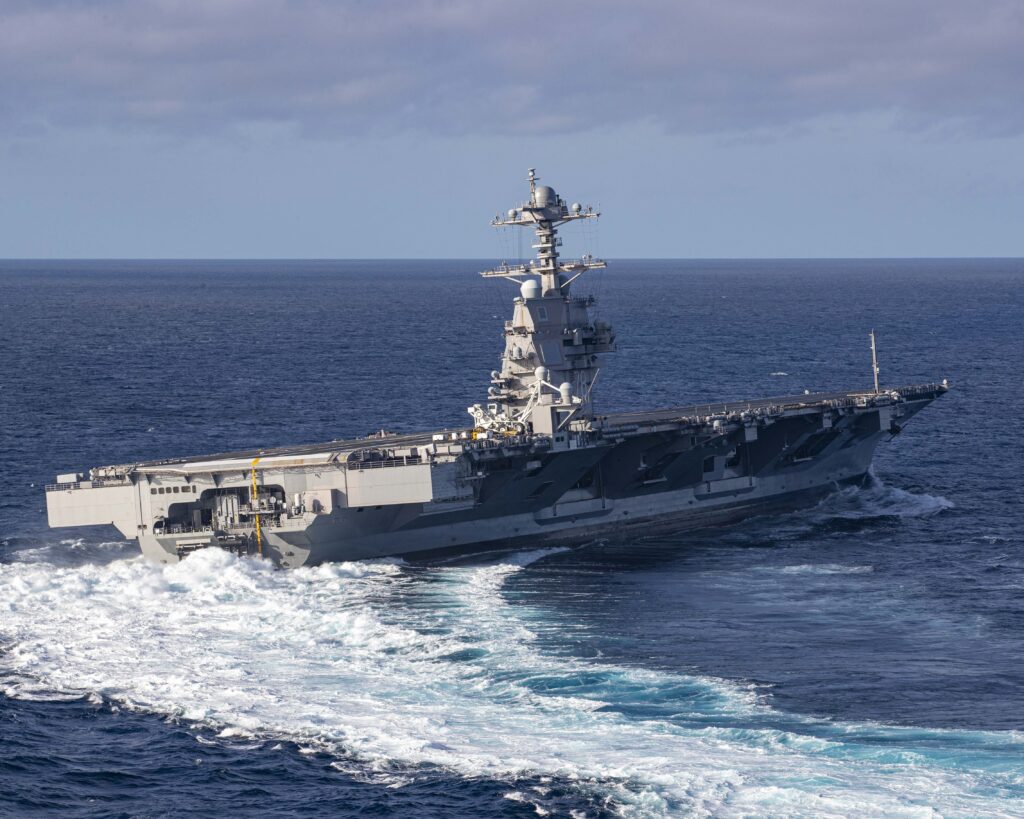
USS Gerald R. Ford conducts high-speed turns in the Atlantic Oct. 27.
WASHINGTON: Navy Secretary Richard Spencer, hours after the USS Ford returned to port after sea tests, renewed his criticism of its shipbuilder, Huntington Ingalls, for failures installing new technologies aboard the nation’s newest and most expensive aircraft carrier, leading to schedule slippages and cost overruns.
Refusing to backtrack from previous criticisms and admitting anew he has questioned if executives at Huntington “really know what they’re doing,” Spencer did signal a new detente with a congresswoman he sparred with recently about the Ford class, however.
Rep. Elaine Luria, who served as a Naval officer for 20 years, has blasted the Navy for problems getting new technologies aboard the $13.2 billion USS Gerald R. Ford to work properly, and failing to provide Congress with a schedule for when the fixes will wrap up. The delays have forced the service to blow through cost caps and postpone testing on the ship by about a year, leading Luria to label the Ford little more than a “$13 billion nuclear-powered berthing barge.”
Spencer promptly returned the favor, telling a think tank audience last week that such criticism by members of Congress amounts to a “disinformation program for our competitors.”
In a thaw in the relationship however, on Tuesday Luria and Navy acquisition boss James Geurts met in her Capitol Hill office to go over the Navy’s plans to fix seven of the ship’s 11 electromagnetic weapons elevators. Luria spokesman Chris Carroll told me it was “a positive meeting,” adding his boss “still has strong concerns about progress on the Ford.” Geurts’ spokesman Capt. Danny Hernandez said the Navy would keep conversations with members of Congress private.
Speaking at a breakfast event at the Heritage Foundation today, Spencer sought to play down the feud, telling reporters the back-and-forth was the result of ”frustration on both sides” over problems on the Ford, adding he shares her frustration over the ship’s problematic technologies and delayed schedule.
Despite the controversy, the Ford returned to port Wednesday after spending five days at sea shaking out the cobwebs after sitting at the dock for 15 months. The ship was originally slated to go to sea in July, but a range of issues — including the elevators — forced the Navy to push the trails back by three months.
Huntington Ingalls holds primary responsibility for the Ford’s elevator issues schedule delays, Spencer said today, building on his previous criticism that the Navy’s confidence in the company’s management “is very, very low.”
The secretary offered a timeline spanning much of the past year, telling reporters that Huntington leadership informed the Navy early in the year the elevators would be ready by July, only to backtrack in May and admit the lifts would not be ready until the end of 2020, or early 2021.
“That was a moment of inflection,” Spencer said. He called the company’s chairman of the board, Tom Fargo, “and I said, this is all hands on deck. Does the board of directors know what’s going on with management here? Because our trust and confidence in this project, specific project of the elevators, has been eroded significantly.”
Not satisfied, Spencer and Geurts decided to take over the elevator work. “And that’s basically what’s happened this last three months: 22,000 work orders knocked down. We have seven elevators moving, four of which are certified; we’re getting after it. Are we late? Yes, we are.”
Asked if cost caps placed on the Ford program by Congress affected the build of the first ship, Spencer wouldn’t explicitly tie the two together, but pushed back on the idea of putting a cost ceiling on a first-in class ship on which the Pentagon directed the Navy install a slew of brand-new technologies, including the elevators, a new radar system, and an electromagnetic launcher to propel aircraft from the deck.
“Sometimes we’re our own worst enemy,” Spencer said. “I still go back and go, what was anyone expecting to have the second- and third-order effects of a cost cap? You don’t get anything for free, and you’re not going to drive quality by cost-capping. We have to start thinking differently when we go to cost control,” he said.
One of the ways shipbuilder Huntington Ingalls sought to keep costs down was to forgo building a land-based test site for the elevators – and installing them without going through the land-based testing regimes that other new technologies on the ship went through.
The caps rose from about $10 billion in 2007 to $13 billion by 2018, all of which the ship has blown past, including a request last month for another $197 million in order to fix seven non-working weapons elevators. The latest request pushed the ship’s cost to $13.2 billion.
“I’d be remiss if I’d say that’s the last,” request for more money, Spencer admitted. “To be very frank, I’d rather have the option to say we’re going to come for more than to say we’re capped off now. I feel good on what we’re finally learning at the end of this.”
Meeting with reporters in his Pentagon office earlier this week, Geurts had a similar take on Congress capping funding while the program was still evolving.
“The downsides of a cost cap outweigh the upsides of a cost cap,” Geurts said. “I just worry for something we’re building for 50 years on a cost cap. You may be forced to do some short-term decisions that have longer-term impacts.”
Global military spending hits ‘all-time high’ of $2.4 trillion: SIPRI report
The US remains the world’s largest defense spender, outlaying $916 billion last year, a 2.3 percent annual increase, ahead of China in second place, which spent an estimated $296 billion, a 6 percent increase over the same period.



























